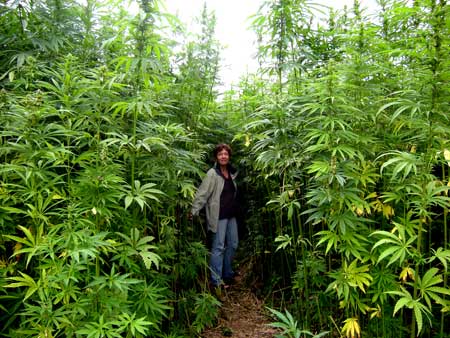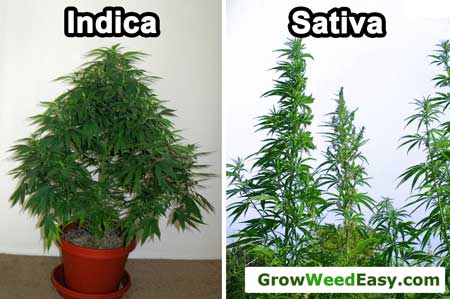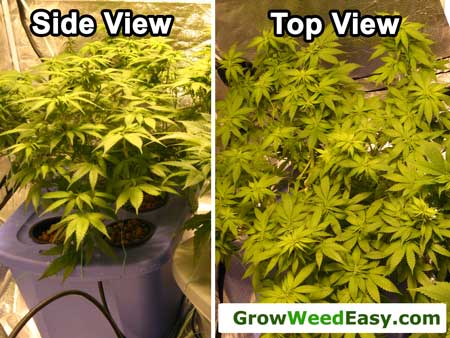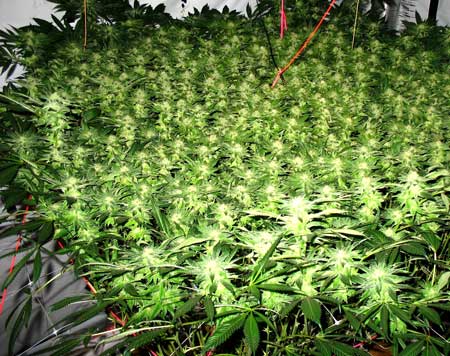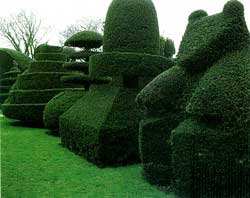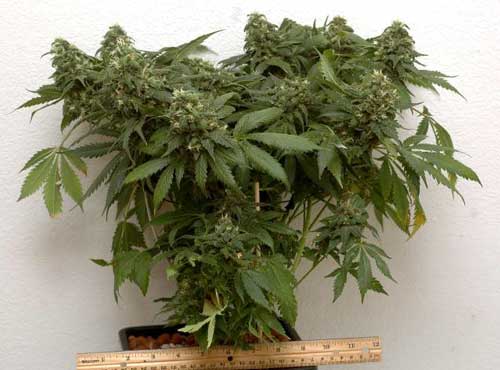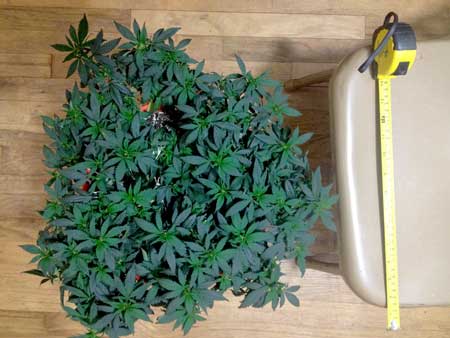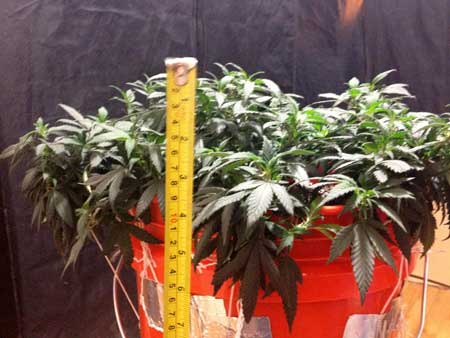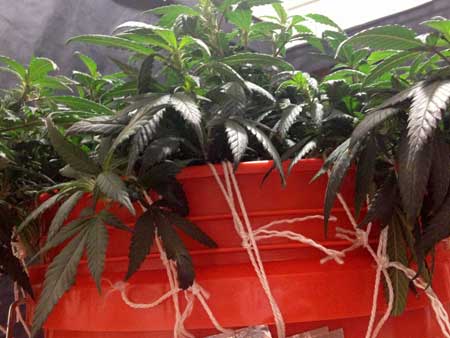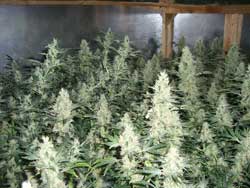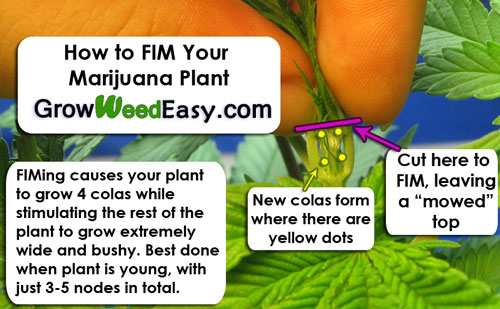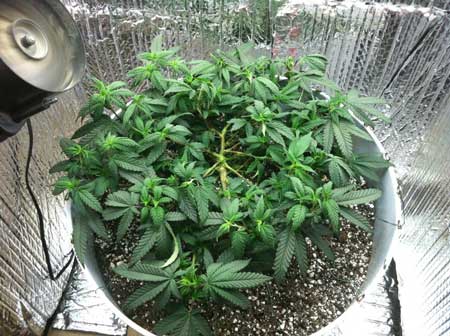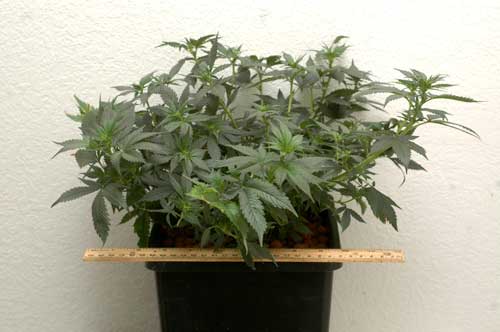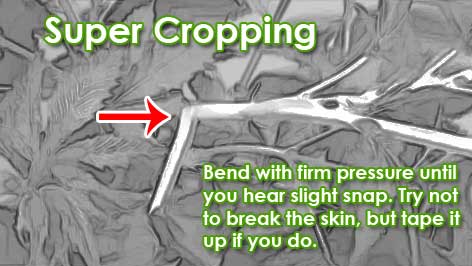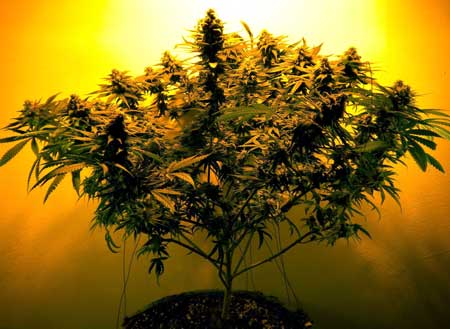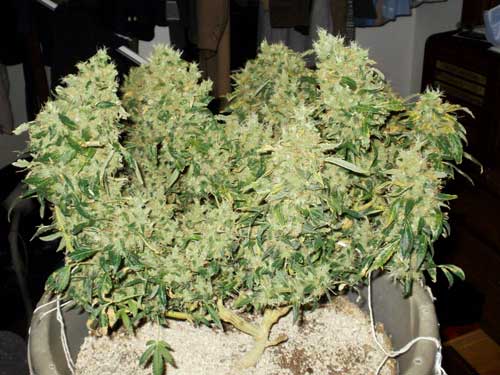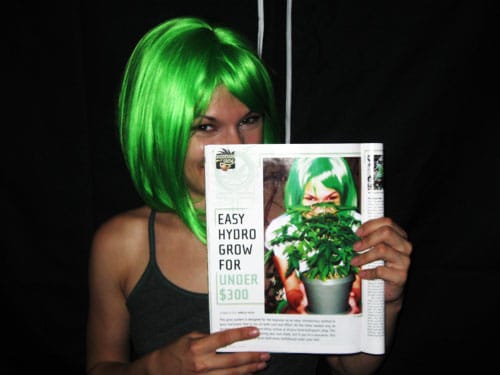by Nebula Haze
Use LST to Force Any Marijuana Plant to Grow As Short As You Want
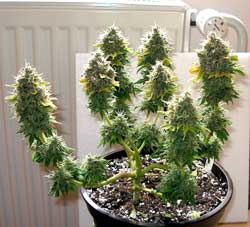
This gives you the power to grow a short Sativa, a short Haze, or basically force any strain to grow short. With LST, the idea is to train your plants to grow in the exact shape you want.
To do this, you must actually ‘bend’ or otherwise gently manipulate the plant to control growth so it grows in the desired shape.
The low stress training (LST) techniques described below are considered a “low stress” way to control your marijuana plants. Low stress training includes techniques such as bending, tying down, and supercropping, as well as techniques that involve cutting your plant.
I highly recommend getting a spool of twisty tie (soft, bendable wire) to tie your plants down with. This can be tied to weights, to the pots your plants are in, your hydroponics bucket, or most anything. It’s wire, so it can be easily hooked around branches without having to tie anything and get your hands in the plant.
Skip the theory and jump straight to how to LST.
Why Does LST Work?
Like many plants, the marijuana plant generally has apical dominance.
Apical dominance means it tends to grow with one straight “trunk” with many branches in a triangle shape, much like the conifer tree pictured to the right.
Strains Grown For Marijuana Buds
Now the strains that we grow for cannabinoids have been specially chosen over the years to produce bigger, more potent flowers.
These strains often grow a bit differently than wild hemp, though there are some similarities. By looking at what’s the same, and what’s different, you’ll gain a better understanding of what you need to do to train your plants to grow exactly how you want.
Here’s an example of cannabis plants in the wild:
There are 2 major phenotypes that marijuana plants tend to display. These are often referred to as “Sativa” and “Indica,” though almost any plant you grow is going to be a hybrid which will display a mixture of characteristics.
If you leave these plants to themselves, and don’t control their growth with training techniques like LST, then…
Sativa-dominant strains tend to grow very tall, with thin leaves, while Indica-dominant strains grow shorter with fatter leaves, often in a Christmas tree shape.:
Remember! It is almost impossible to obtain a “pure” indica or sativa strain, most marijuana strains will show a mixture of these traits!
The problem is that both these shapes are not well-suited for indoor growing.
They are made to maximize the light received by the sun, which moves across the sky. These plant shapes do not efficiently use the light produced by grow lights, which are oftenlocated directly above the plants.
Therefore, for indoor grows, there’s lots of benefits to training your marijuana plants to grow short, bushy, and to create a horizontal “table” of buds.
These plants are better able to use your light, like this plant pictured here.
Notice in the top view how there’s a much wider “spread” to catch light?
Training your plants to grow flat and short this way maximizeds your grow lights, resulting in better yields for the dedicated grower.
This incredible picture was taken by ogkushog. Now you can learn how he used ScrOG, a popular marijuana training technique, to produce this beautiful sea of buds.
LST (Low Stress Training)
Jump straight to section on how to LST.
The marijuana training technique you will learn today is called LST, which is short for low stress training.
The point of LST is to break your plant away from how it naturally tends to grow, and force your plant to grow in a specific shape, like the topiary pictured to the right.
LST can be used to train indica-dominant or sativa-dominant strains to grow into just about any shape you want.
Today I’ll show you how you can use LST to train your marijuana plants into a “Star” shape, to make the best use of your indoor grow lights.
LST gives you the power to grow any strain indoors, including Sativa and Haze-dominant strains, which tend to grow too long and thin to produce good yields indoors, yet are sought-after for their unique energizing high and medicinal effects.
So how exactly do you grow a short Sativa indoors?
In the past, we’ve already covered several methods to keep plants short, including increasing the amount of light, restricting roots from being able to get bigger, and even controversial growth control methods like defoliation.
Picture by SuperAngryGuy
Yet today, we’re going to look into the simplest and cheapest way you can gain complete control over how your marijuana plants grow.
The secret is LST.
So what exactly is low stress training?
LST or low stress training means the process of using physical manipulation to train your plant to grow the way you want.
In other words, you’re bending plants to your will, so they grow in the exact shape you need for your grow space.
As you increase the amount of plant surface area which is receiving direct light, you increase your overall plant growth and bud development.
Low stress training is used on many different kinds of plants, from bonsai trees to cannabis.
With LST, you can train your plants in the marijuana vegetative stage to grow as short as you desire. Take a look at the pictures below by likebigbudscannotlie.
Notice how much leaf surface area there is to catch light
Yet this plant has been kept very short
Pictures by likebigbudscannotlie
LST is rarely used alone. It is almost always combined with a cutting technique to produce multiple colas (such as topping or FIMing).
The purpose of cutting techniques is to break the apical dominance of a marijuana plant. When you cut the main “trunk” of a marijuana plant, she starts branching out and making multiple colas.
Because of this, in addition to allowing your plant to make better use of your indoor grow lights, as you can see from the picture above, LST also encourages your plant to grow multiple main colas instead of just one.
Each of these colas will produce buds, giving you plants that look like this as you approach harvest:
Step 1: Top or FIM your young plant when she’s only got 3-5 nodes.
Learn how to top or FIM your marijuana plant or use the following quick guides:
The purpose of any marijuana cutting technique is to break the apical dominance of a marijuana plant. When you cut the main “trunk” of a marijuana plant, she starts branching out and getting bushier.
Topping or FIMing also makes a marijuana plant more accepting to low stress training after she’s recovered.
Using either of these techniques (FIM or top) will encourage your plants to start growing more wide and bushy.
I prefer to FIM plants since this forms a more symmetric 4 colas instead of only 2, and because this is less stressful to the plant and barely slows down growth.
However, if you look at the incredible pictures and writeup by ogkushog, you’ll see he only tops his plants and never FIMs.
The truth is, both FIMing and topping are very effective ways to produce more colas, and it’s a matter of personal choice which one will work best for you.
Step 2: Spread out your branches so they lie flat and secure them. Think of creating a “star” shape when looking down from above.
In the beginning, you want to bend branches away from the middle of the plant and tie them down. Here’s the sort of star shape I’m talking about:
Some strains/branches will bend more easily than others. Young growth is almost always easier to bend than old growth.
You can tie down branches with anything, though gardening wire (soft wire tie for the garden, often found at gardening stores) works perfectly since you can easily bend it to any shape you want.
I usually bend the wire to form a hook on each end. I hook one end to a branch, and the other to my pot, or anything else you can think of.
Some growers will drill holes in their containers to make tying plants down even easier.
Another popular option for Low Stress Training is zipties, since they’re strong, cheap, and can be adjusted.
It’s best to hook your ties to something that will always remain level with your plant. You can also hook your ties to fishing weights or even stick them straight into the soil.
The last common LST is using a technique known as ScrOG, which means that you use a screen to force plants to grow horizontally (using a screen made of homemade string fencing, netting, or anything else that can be used to secure plants).
Learn more about how one grower used LST and ScrOG to grow an incredible sea of buds!
LST can be used to create incredibly short plants in a very short amount of time.
Picture by SuperAngryGuy
No matter how you secure your plant, the main idea is for it to hold down the branches in the shape that you want, while still allowing you to easily tend to your plants as they gets bigger.
That’s worth repeating, don’t tie down your plants in such a way that you won’t be able to tend them or move them! You’ll regret it later!
Step 3: Supercropping (optional)
Some growers also gently bend flexible branches until they snap slightly or crush the bent part between their fingers to cause slight damage to the bent point. This technique is known as super cropping.
This illustration shows a perfect example of a super crop, one that doesn’t even need tape. Use tape if you go a little overboard.
Read full super cropping guide here
Manipulating your plant with bending or super cropping causes the entire plant to naturally grow more bushy, while you’re also controlling the parts of the plant that aren’t growing the way you want.
Basically you’re training the plant to grow into the shape you desire, like a marijuana bonsai tree. You train the plant slowly and take care not to hurt you plant. You don’t want to snap any of the branches, and never try to bend stiff branches or they’ll just break off.
By using this method alone, you can grow a plant that conforms to any shape that you want.
If I am growing two strains of marijuana, and one tends to be taller than the other, I’ll bend over the taller one as much as 90 degrees so that it is the same height as the shorter plant.
I also bend the tallest branches down, crush the ‘joint’ between my fingers, and tie the branch down to the pot she’s growing with (or to fishing weights on the floor, or anything else you can use as an anchor).
Most growers want to avoid the Xmas Tree shape because it’s hard to get light coverage and instead encourage a plant to grow with more of a flat plane of buds.
This allows a more even distribution of light and the the whole stem of the bend plant will get equal access to the light. Eventually all the buds on a bent branch will start growing upward toward the light. After initially bending your plant, growth will be slowed for few days as the plant recovers.
In addition, one of the natural reactions to being extremely bent over is the marijuana plant will stop trying to grow upward as much.
As a result, all the lower branches will start getting more bushy.
Bending, supercropping, and other low-stress training are great ways to maximize your marijuana yields whne you have a small amount of vertical room.
Step 4: Repeat Step 2-3 throughout Vegetative stage and continue into first few weeks of Flowering Stage
LST In Vegetative Stage
It is essential that you start any LST as soon as possible. It’s best to start when your plant is very young, though with LST, it’s better late than later, and better later than never.
Continue to LST your plant throughout the vegetative stage. When you’ve transformed your plant into a horizontal table, you’re ready to start flowering
LST In Flowering Stage
Once your plant starts flowering, you will need to continue to use LST for the first few weeks as your plant goes through her final growth spurt.
After the first month of flowering, your work is pretty much done. Your plant is putting all her energy into making flowers/buds, and your plant structure will not change much during the last several weeks of flowering.
This late into flowering, it’s best to only use LST when you have a troublesome branch that is cutting off light to other parts of the plant.
It is NOT recommended that you start LST in flowering. Proper LST must begin when the plant is young, because by the time you get fully into the flowering stage, the majority of the plant structure has already been formed.
If you’ve LST’ed properly in the vegetative stage, your plant should naturally start growing rows of colas along the flat table you produced, and you’ll get plants that look like the incredible trophy pics displayed on this page.
As you spend time training and observing your plants, you’ll begin to get a much better understanding of how this plant grows
Picture by Dankmadness
Still want more info? Read LBH’s Famous 4-way LST tutorial or check out the ultimate resource below!
LST is more of an art form than a science, and it’s time for you to bring out your inner artist!
If you haven’t started growing marijuana yet, today is the day!
If you run into any problems while you’re growing marijuana, you don’t have to figure everything out alone. Use our handy marijuana problem picture guide to quickly diagnose your plant: https://www.growweedeasy.com/marijuana-symptoms-pictures
About the Author: Nebula Haze
In response to the need for more tutorials aimed at new growers, Nebula co-founded GrowWeedEasy.com in 2010 with fellow grower Sirius Fourside.
Since then, Nebula has published dozens of growing articles in print and online, stars in online video lessons, and continues to dedicate herself to serving the needs of the medical marijuana growing community.
“My mission is to show other medical marijuana patients how easy and fun it can be to grow pounds of killer weed out of your closet.”
Wanna “steal” this article?
Here at GrowWeedEasy.com, we are dedicated to getting this information into as many hands as possible. You are welcome to republish this entire article as long as you do not edit, remove or or otherwise change any part of it without permission, including this message at the end.
Please don’t hesitate to Contact GrowWeedEasy.com with any questions.
Happy growing!

